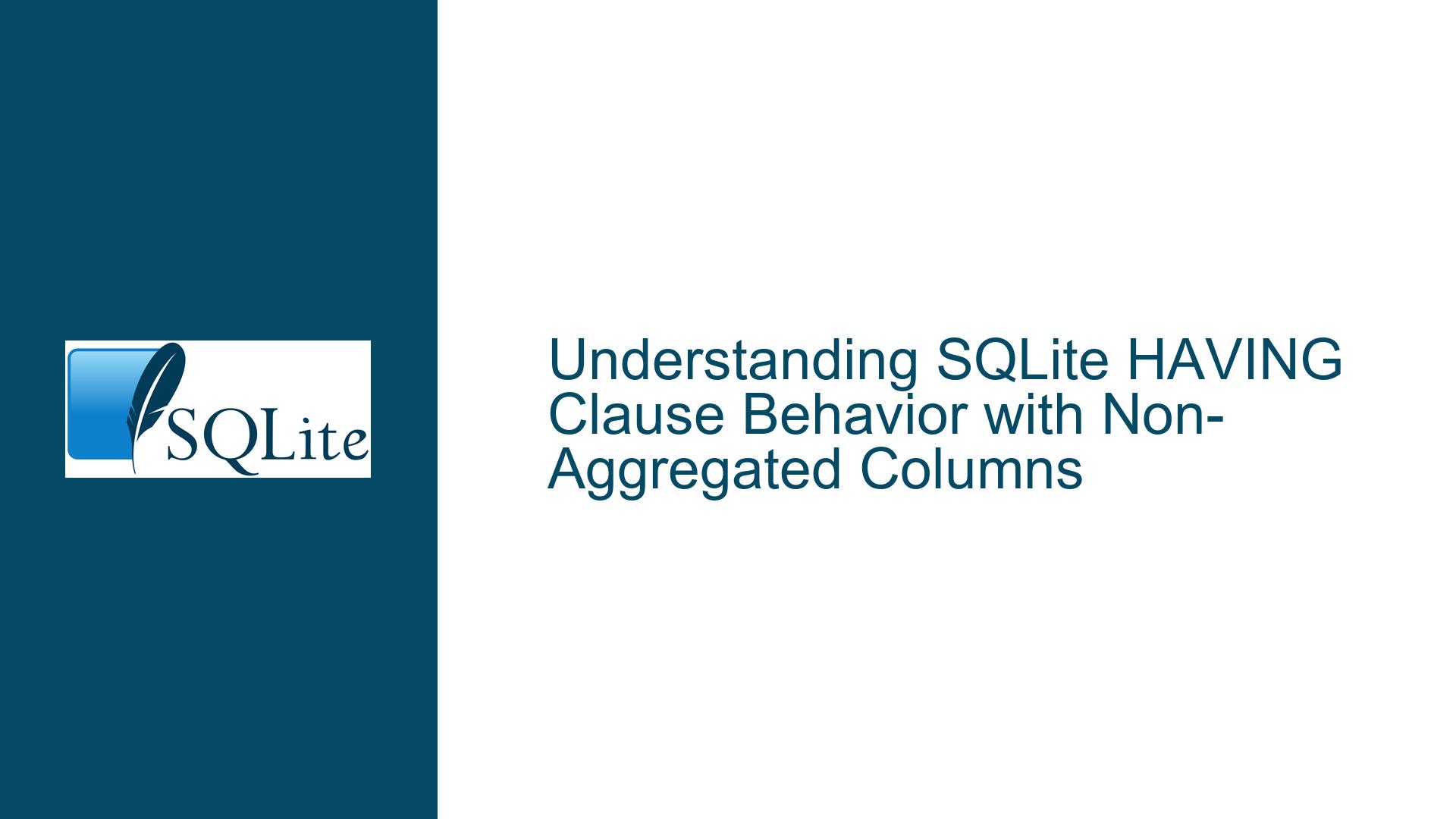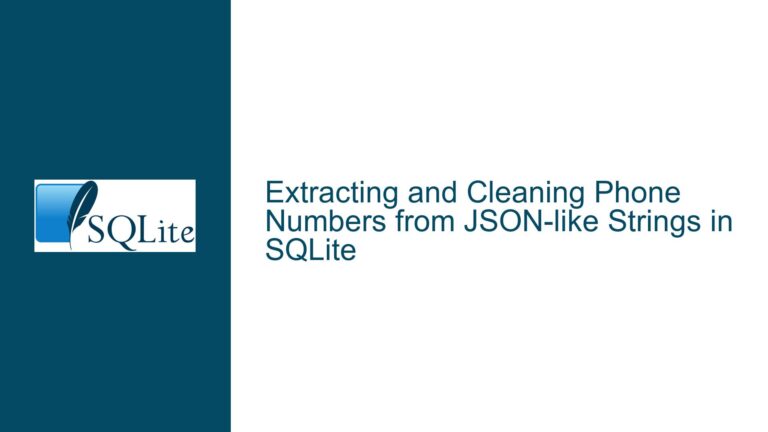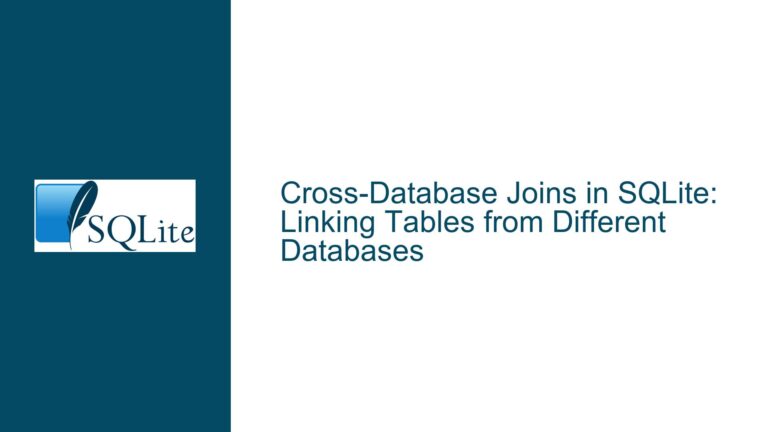SQLite HAVING Clause Behavior with Non-Aggregated Columns
Issue Overview: HAVING Clause and Non-Aggregated Columns in SQLite
The behavior of the HAVING clause in SQLite when referencing non-aggregated columns can be confusing, especially for developers accustomed to stricter SQL implementations. In SQLite, when a HAVING clause references a non-aggregated column (i.e., a column not included in the GROUP BY clause and not an alias of an aggregate function), the database engine evaluates the expression using an arbitrarily selected row from the group. This behavior is documented but often misunderstood, leading to unexpected query results.
For example, consider the following query:
WITH cte(k, v) AS (
VALUES
("a", 1),
("a", 0),
("b", 0),
("b", 1),
("c", 1),
("c", 0)
)
SELECT k
FROM cte
GROUP BY k
HAVING v = 1;
The query groups rows by the column k and applies a HAVING filter on the non-aggregated column v. The result includes groups where the arbitrarily selected row for v satisfies the condition v = 1. In this case, the groups a and c are returned because SQLite happens to select rows where v = 1 for these groups. However, this behavior is not deterministic and can vary depending on the internal implementation of SQLite.
This behavior is rooted in SQLite’s lenient handling of non-aggregated columns in aggregate queries. Unlike some other SQL databases, SQLite does not enforce strict rules requiring all non-aggregated columns in the SELECT clause to be part of the GROUP BY clause. Instead, it allows non-aggregated columns to be referenced in the HAVING clause, but the value used for comparison is chosen arbitrarily from the group. This can lead to confusion, especially when the query results appear inconsistent or non-intuitive.
Possible Causes: Why SQLite Behaves This Way
The behavior of SQLite’s HAVING clause with non-aggregated columns stems from two key design decisions in the database engine: its lenient handling of non-aggregated columns and its internal optimization strategies.
Lenient Handling of Non-Aggregated Columns
SQLite is designed to be lightweight and flexible, which includes allowing non-aggregated columns in aggregate queries without requiring them to be part of the GROUP BY clause. This design choice simplifies query writing in many cases but introduces ambiguity when non-aggregated columns are referenced in the HAVING clause. Since the column is not aggregated and not part of the GROUP BY, SQLite must choose a value from the group to evaluate the HAVING condition. The choice of value is implementation-dependent and not guaranteed to be consistent across queries or SQLite versions.
Internal Optimization Strategies
SQLite’s query optimizer is designed to minimize resource usage and maximize performance. When evaluating a HAVING clause with a non-aggregated column, the optimizer may choose the first available row in the group that satisfies the condition, as this approach reduces computational overhead. However, this optimization can lead to non-deterministic behavior, as the choice of row is not explicitly defined by the SQL standard or SQLite’s documentation.
Comparison with Other Databases
In contrast, many other SQL databases enforce stricter rules for aggregate queries. For example, MySQL and PostgreSQL require all non-aggregated columns in the SELECT clause to be part of the GROUP BY clause. This enforcement ensures deterministic behavior but can make query writing more verbose. SQLite’s approach prioritizes flexibility and simplicity, which can be advantageous in certain use cases but requires developers to be aware of its nuances.
Troubleshooting Steps, Solutions & Fixes: Addressing the Issue
To address the issue of non-deterministic behavior in SQLite’s HAVING clause with non-aggregated columns, developers can take several approaches, ranging from query restructuring to leveraging SQLite’s unique features.
Restructuring the Query
One effective solution is to restructure the query to avoid referencing non-aggregated columns in the HAVING clause. This can be achieved by using subqueries or window functions to explicitly define the desired behavior.
For example, the original query can be rewritten using a subquery to filter rows before applying the GROUP BY clause:
WITH cte(k, v) AS (
VALUES
("a", 1),
("a", 0),
("b", 0),
("b", 1),
("c", 1),
("c", 0)
)
SELECT k
FROM (
SELECT k, v
FROM cte
WHERE v = 1
)
GROUP BY k;
This approach ensures that only rows satisfying the condition v = 1 are considered for grouping, eliminating the ambiguity introduced by the HAVING clause.
Using Aggregate Functions
Another approach is to use aggregate functions to explicitly define the desired behavior. For example, if the goal is to filter groups based on the presence of a specific value in the non-aggregated column, the MAX or MIN function can be used:
WITH cte(k, v) AS (
VALUES
("a", 1),
("a", 0),
("b", 0),
("b", 1),
("c", 1),
("c", 0)
)
SELECT k
FROM cte
GROUP BY k
HAVING MAX(v) = 1;
This query ensures that only groups containing at least one row with v = 1 are included in the result, providing deterministic behavior.
Leveraging Window Functions
Window functions can also be used to address the issue by partitioning the data and applying the filter condition before grouping:
WITH cte(k, v) AS (
VALUES
("a", 1),
("a", 0),
("b", 0),
("b", 1),
("c", 1),
("c", 0)
),
filtered_cte AS (
SELECT k, v,
ROW_NUMBER() OVER (PARTITION BY k ORDER BY v DESC) AS rn
FROM cte
WHERE v = 1
)
SELECT k
FROM filtered_cte
WHERE rn = 1
GROUP BY k;
This approach uses a window function to assign a row number to each row within its group, ensuring that only the first row satisfying the condition is considered for grouping.
Understanding SQLite’s Documentation
Developers should familiarize themselves with SQLite’s documentation, particularly the sections on aggregate queries and the HAVING clause. The documentation explicitly states that non-aggregated expressions in the HAVING clause are evaluated with respect to an arbitrarily selected row from the group. This understanding is crucial for writing queries that behave as intended.
Testing and Validation
Given the non-deterministic nature of SQLite’s behavior, thorough testing is essential to ensure that queries produce the desired results. Developers should test their queries with various datasets and edge cases to validate their behavior. Additionally, using tools like DB Fiddle can help identify and resolve issues in a controlled environment.
Best Practices
To avoid issues with non-aggregated columns in the HAVING clause, developers should adhere to the following best practices:
- Avoid referencing non-aggregated columns in the
HAVINGclause unless absolutely necessary. - Use subqueries, aggregate functions, or window functions to explicitly define the desired behavior.
- Test queries thoroughly to ensure they produce consistent and expected results.
- Consult SQLite’s documentation to understand the nuances of its behavior.
By following these steps and best practices, developers can effectively address the issue of non-deterministic behavior in SQLite’s HAVING clause and write robust, reliable queries.






